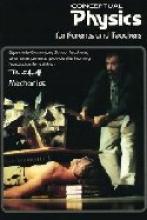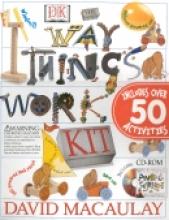Mechanics
Conceptual Physics for Parents and Teachers, Book One: Mechanics
Subtitle: Especially Elementary School Teachers, who, after parents, provide the learning foundation for children The Conceptual Physics series is designed to make scientific concepts more accessible to parents and teachers. The hope is that a greater understanding on our part will lead to more and better information for children at a young age so that they might begin to develop an interest in science and the wonders of the world around them. The author explains that the current emphasis in education seems to be on the process of how we came to understand certain things and that many students leave school without understanding basic concepts of gravity, motion, etc. His book is an attempt to remedy that situation.
I think the author does a commendable job at fulfilling this task. Although he introduces readers to the mathematical expressions used to describe certain concepts, his emphasis is on helping the reader to understand the concepts themselves. Mr. Hewitt has given the book a great deal of personality. Rather than being very "textbook-like", studying the book has more of the feel of going through the basics with a good highschool teacher - humor, interesting tidbits, etc. His explanations, profuse "real-life examples" and an ability to anticipate common misunderstandings do make these concepts accessible. I'm not going to pretend that working your way through this book is a breeze. For a rather non-scientific person like myself it required a bit of determination, particularly in getting started. However, once I got into the book a bit, I found it both engaging and interesting. The author clearly wants to make you think rather than simply filling you head with information. At one point he even mentions that "Good teaching isn't providing answers–it's asking good questions." Like any good teacher, he challenges you while keeping you interested. There are little question and answer sections scattered through the text to ensure that you're staying on track (I'm happy to say that I was able to answer most of these correctly). I especially enjoyed the experiments. They are simple enough to try at a moment's notice and even my children, who are ages six and under, were delighted to try them out with me. These experiments led to a lot of "ooh"s and "wow"s and some good discussions around the dinner table. Clearly, in my family, the aim of the author was accomplished.
The book covers a substantial quantity of information, including the following concepts: equilibrium, vectors, tension, motion, speed, velocity, acceleration, free-fall, mass, weight, force, friction, pressure, momentum, bouncing, energy, work, power, efficiency, rotational motion, torque, center of gravity, stability, and gravity. He frequently relates these concepts to interesting, "real-life" situations such as calculating the "hang-time" of basketball players, explaining how people can walk on broken glass or lie on a bed of nails without getting hurt, why long poles help tightrope walkers balance, how gravity causes tides and even a bit about black holes. Obviously this is a lot of material to cover in a book of 179 pages. He doesn't explain the entire history of how we've come to understand each concept, but focuses on helping the student understand how these concepts work based on scientific research to date. Anyone who studies the book will have a much greater understanding of physics than the average American. For some this may even be a springboard for a much greater interest in Science.
The only real problem I had with the technical chapters of the book (1 - 8) is a slightly belittling tone the author takes toward Aristotle. It comes in the context of Galileo and Newton's advances in understanding motion which revolutionized the beliefs of their day which had originated with Aristotle. I think it's largely due to his informal style and probably not intentional, but I think it's a point worthy of mention. I want to instill in my children a respect for the great thinkers of the past. It's easy for us today to become arrogant about our technological advances, but I think we need to remember how much of our progress today would have been impossible without those who preceeded us.
The final chapter (9) is entitled "On Science." Here the author presents some of his philosophies about what science is. He also makes some very useful distinctions about the meanings of words in a scientific context as compared to "ordinary speech". I thought his explanations about the attitudes required of a good scientist were very helpful. There is a lot of very good food for thought in this chapter and some particularly excellent quotes. One of my favorites was, "In your education it is not enough to be aware that other people may try to fool you; it is more important to be aware of your own tendency to fool yourself." (People would do well to consider that idea in any profession!) I was impressed with his sincerity and surprised by how well he presented the idea of the complementarity of science and religion (for a secular text). This was particularly enhanced by a quote of Einstein's he includes: "Science without religion is deaf; religion without science is blind." We Catholics aren't afraid of science. We believe that faith and reason work together. (An abundance of excellent reading material on this topic can be found on the Internet. I recommend the website: Creation, Creationism and Empirical Theistic Arguments and Pope John Paul II's encyclical On Faith and Reason (Fides et Ratio).)
Unfortunately I found some areas of the last chapter where the author goes beyond the realm of his expertise and includes some statements which lack the clarity present in most of his text. I think that he muddles some points by using controversial subjects as examples. Also expect a few "off-the-wall" comments such as "Truth is a word seldom used in science (it seems to me that those who say they seek only 'the truth' are more often seeking confirmation of what they already hold as true, and anything found that contradicts rather than supports, is discarded)."[p. 165] and "It was then that I learned that right and wrong are relative terms. By definition, we're right and they're wrong. Few of us question what we've been taught to believe." [p. 166]
In good natured curiosity then, if right and wrong are relative terms and science does not concern itself with the truth, how can the author be so sure that Aristotle was wrong?
You can read more about this title on the Focus Publishing Website.
black and white illustrations and photos
The Way Things Work Kit
This kit provides dozens of special cardboard pieces, wooden dowels string, wheels, etc. for making simple machines (inclined planes, scales, etc.) that can be used for understanding basic concepts of mechanics - how things work. Based upon the bestselling "The Way Things Work" by David Macaulay, the kit continues the theme of Wooly Mammoths as props and characters for use in these experiments. (Included in the kit are two cardboard Wooly Mammoths to which you affix a certain number of identical coins to provide a common weight for some of the experiments.) A thin, but colorful book (32 pages - glossy cover) takes you through the scientific explanations of the various principles involved in the experiments. 5 1/2 " x 8 1/2" glossy full color cards provide detailed step-by-step instructions (with the typical DK photos) for each experiment.
Although some of the experiments took a little more finesse than might have been expected (but understandable due to the limitations of the materials) and some of the instruction cards were a little hard to follow, overall we found this to be an exceptional value - a lot of bang for your buck at the $30 retail price. We found that a dozen or so ziploc bags were very helpful in keeping the various pieces straight and, with a little patience, all the pieces can be stored in the box.
The biggest hit in our family so far was the Pinball Science CD ROM which also came with the kit.  The game includes three pinball arenas each having a specific theme (village, island and moon). The science part involves answering questions in order to earn the right to place certain fixtures on each pinball game. Without the fixtures, scores are lower and players are unable to advance to the next level. With each question, the player has the option to "Research Answer". This feature takes the player to the appropriate page in an interesting, humorous and interactive log book which explains the functioning of various devices such as windmills, faucets, hot-air balloons, gears, and rockets. Some of the graphics are a little silly (Wooly Mammoths in bikinis on the island and such), but I didn't find anything really objectionable.
The game includes three pinball arenas each having a specific theme (village, island and moon). The science part involves answering questions in order to earn the right to place certain fixtures on each pinball game. Without the fixtures, scores are lower and players are unable to advance to the next level. With each question, the player has the option to "Research Answer". This feature takes the player to the appropriate page in an interesting, humorous and interactive log book which explains the functioning of various devices such as windmills, faucets, hot-air balloons, gears, and rockets. Some of the graphics are a little silly (Wooly Mammoths in bikinis on the island and such), but I didn't find anything really objectionable.


